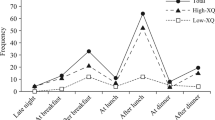Abstract
The knowledge on the determinants of oral health-related quality of life (OHQoL) is still fragmentary. The aim of this study was to examine the influence of different socio-economic, behavioral, and clinical variables on OHQoL in a cross-cultural patient sample in Germany and Canada. The study had a cross-sectional design. It was conducted at five examination sites at clinics managed by the Technische Universität Dresden (Germany) and the University of Alberta (Canada), with the sites representing different cultural and socio-economic variables. Incoming patients satisfying the defined inclusion and exclusion criteria were asked to participate. Subjects who had been to a dentist within the last 3 months were excluded to avoid bias related to recent experiences associated with ongoing treatment. OHQoL was measured with the 49-item version of the OHIP (Oral Health Impact Profile) questionnaire (OHIP-49) together with age, gender, attendance and a set of oral health variables. The OHIP questions are organized into seven dimensions: functional limitation, physical pain, psychological discomfort, physical disability, psychological disability, social disability, and handicap. All questions refer to the experiences of the subject in the preceding 12 months. Descriptive, univariate, and multivariate methods were applied in data analysis. Based on the results of the multivariate logistic regression analysis, only gender, removable denture wearing, and treatment need in endodontics, surgery, and prosthetics remained as significant explanatory variables in the final model for impaired OHQoL. With the OHIP subscale handicap being the dependent variable, missing anterior teeth (regardless of replacement), treatment need in surgery, and the time of the last dental visit were significant indicators of high – i.e. unfavorable – scores. In this patient sample, impaired OHQoL was associated with several factors. The examination site, however, was not among the explanatory variables in the final models, as had been expected, thus indicating the absence of cross-cultural differences.
Similar content being viewed by others
References
Allen PF, McMillan AS, Locker D (2001) An assessment of sensitivity to change of the Oral Health Impact Profile in a clinical trial. Community Dent Oral Epidemiol 29:175–182
Allison P, Locker D, Jokovic A, Slade G (1999) A cross-cultural study of oral health values. J Dent Res 78:643–649
Antonovsky A (1993) The structure and properties of the sense of coherence scale. Soc Sci Med 36:725–733
Heydecke G, Locker D, Awad MA, Lund JP, Feine JS (2003) Oral and general health-related quality of life with conventional and implant dentures. Community Dent Oral Epidemiol 31:161–168
Heydecke G, Tedesco LA, Kowalski C, Inglehart MR (2004) Complete dentures and oral health-related quality of life – do coping styles matter? Community Dent Oral Epidemiol 32:297–306
John MT, Patrick DL, Slade GD (2002) The German version of the Oral Health Impact Profile-translation and psychometric properties. Eur J Oral Sci 110:425–433
John MT, LeResche L, Koepsell TD, Hujoel P, Miglioretti DL, Micheelis W (2003) Oral health-related quality of life in Germany. Eur J Oral Sci 111:483–491
John MT, Koepsell TD, Hujoel P, Miglioretti DL, LeResche L, Micheelis W (2004a) Demographic factors, denture status and oral health-related quality of life. Community Dent Oral Epidemiol 32:125–132
John MT, Slade GD, Szentpetery A, Setz JM (2004b) Oral health-related quality of life in patients treated with fixed, removable, and complete dentures 1 month and 6 to 12 months after treatment. Int J Prosthodont 17:503–511
Larsson P, List T, Lundstrom I, Marcusson A, Ohrbach R (2004) Reliability and validity of a Swedish version of the Oral Health Impact Profile (OHIP-S). Acta Odontol Scand 62:147–152
Locker D (1995) Health outcomes of oral disorders. Int J Epidemiol 24[Suppl1]:85–89
Locker D, Miller Y (1994) Evaluation of subjective oral health status indicators. J Public Health Dent 54:167–176
Locker D, Slade G (1993) Oral health and the quality of life among older adults: the oral health impact profile. J Can Dent Assoc 59:830–833
McGrath C, Bedi R (2001) An evaluation of a new measure of oral health related quality of life - OHQoL-UK(W). Community Dent Health 18:138–143
Savolainen J, Suominen-Taipale AL, Hausen H, Harju P, Uutela A, Martelin T, Knuuttila M (2005) Sense of coherence as a determinant of the oral health-related quality of life: a national study in Finnish adults. Eur J Oral Sci 113:121–127
Slade GD (1997a) The oral health impact profile. In: Slade GD (ed) Measuring oral health and quality of life. University of North Carolina, Chapel Hill
Slade GD (1997b) Derivation and validation of a short-form oral health impact profile. Community Dent Oral Epidemiol 25:284–290
Slade GD, Spencer AJ (1994) Development and evaluation of the oral health impact profile. Community Dent Health 11:3–11
Slade GD, Spencer AJ, Locker D, Hunt RJ, Strauss RP, Beck JD (1996) Variations in the social impact of oral conditions among older adults in South Australia, Ontario, and North Carolina. J Dent Res 75:1439–1450
Steele JG, Sanders AE, Slade GD, Allen PF, Lahti S, Nuttall N, Spencer AJ (2004) How do age and tooth loss affect oral health impacts and quality of life? A study comparing two national samples. Community Dent Oral Epidemiol 32:107–114
Szentpetery AG, John MT, Slade GD, Setz JM (2005) Problems reported by patients before and after prosthodontic treatment. Int J Prosthodont 18:124–131
Wolfart S, Heydecke G, Luthardt RG, Marre B, Freesmeyer WB, Stark H, Wostmann B, Mundt T, Pospiech P, Jahn F, Gitt I, Schadler M, Aggstaller H, Talebpur F, Busche E, Bell M (2005) Effects of prosthetic treatment for shortened dental arches on oral health-related quality of life, self-reports of pain and jaw disability: results from the pilot-phase of a randomized multicentre trial. J Oral Rehabil 32:815–822
Wong MC, Lo EC, McMillan AS (2002) Validation of a Chinese version of the Oral Health Impact Profile (OHIP). Community Dent Oral Epidemiol 30:423–430
Author information
Authors and Affiliations
Corresponding author
Rights and permissions
About this article
Cite this article
Walter, M.H., Woronuk, J.I., Tan, HK. et al. Determinants of oral health-related quality of life in a cross-cultural German-Canadian sample. J Public Health 15, 43–50 (2007). https://doi.org/10.1007/s10389-006-0077-x
Received:
Accepted:
Published:
Issue Date:
DOI: https://doi.org/10.1007/s10389-006-0077-x




